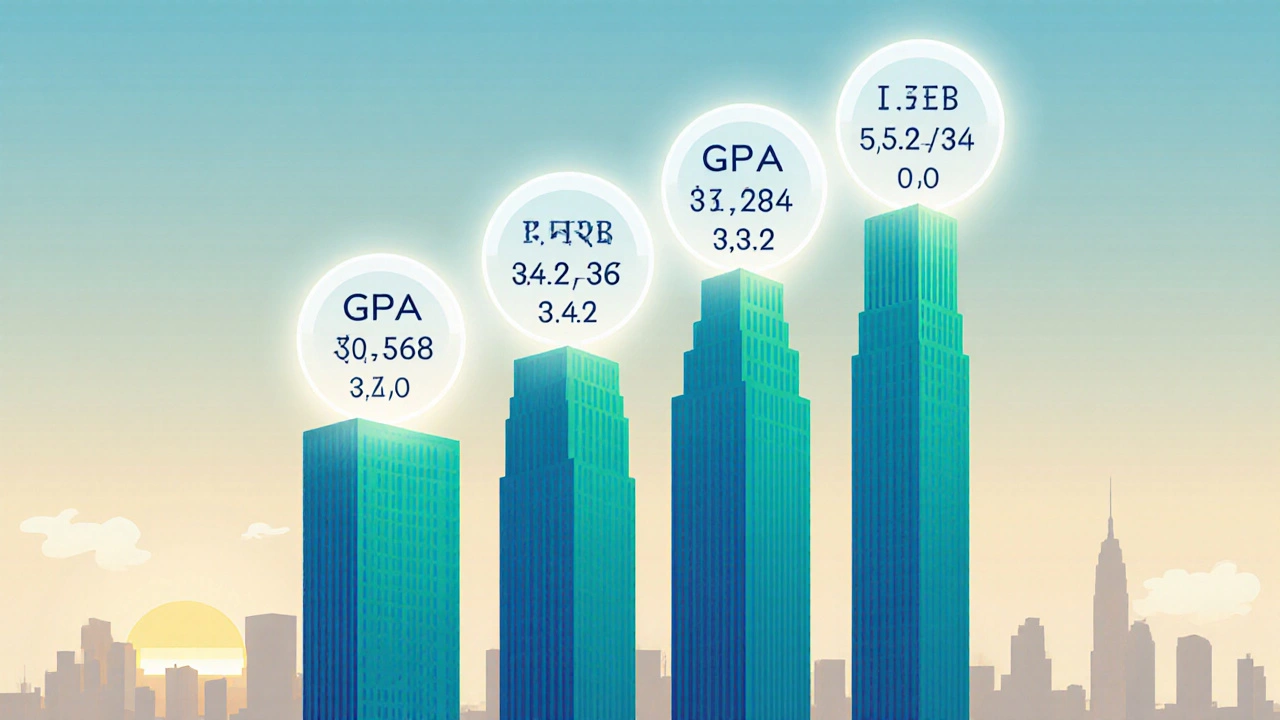When you hear GPA is a standardized measure of a student's academic performance, usually on a 4.0 scale, you start wondering if it’s high enough to get into a top MBA program. The truth is, there isn’t a single magic number that works for every school. Each admissions committee looks at your GPA through a different lens, balancing it against work experience, test scores, essays, and personal story.
In this guide we’ll break down the real thresholds, explain why a ‘low’ GPA can sometimes be salvaged, and give you a step‑by‑step plan to improve your chances. By the end you’ll know exactly what GPA range puts you in the safe zone, what range lands you in the gray area, and when you might need a backup plan.
How MBA Admissions Teams View Your GPA
First, understand that the MBA admissions process evaluates academic credentials, professional achievements, and personal attributes as a whole. Your GPA is just one data point, but it often serves as the gateway metric because it’s the easiest way to gauge academic rigor.
- Signal of academic ability: A high GPA suggests you can handle the quantitative and analytical coursework of an MBA.
- Risk assessment: A low GPA may raise concerns about your capacity to succeed in a demanding curriculum.
- Context matters: Admissions committees adjust expectations based on your major, school reputation, and the difficulty of your undergraduate program.
Because of that, most schools publish an average GPA the mean GPA of recent admitted cohorts. Knowing the average helps you gauge where you stand.
Typical GPA Ranges Across Different School Tiers
Below is a quick snapshot of the most recent data (2024‑25 admissions cycle). These numbers come from school‑released class profiles and reputable MBA ranking reports.
| Tier | School Examples | Average GPA | Typical Minimum GPA |
|---|---|---|---|
| Top 10 (Global Elite) | Harvard, Stanford, Wharton, INSEAD | 3.6 - 3.8 | 3.4 |
| Tier 2 (Highly Competitive) | Kellogg, Duke‑Fuqua, IE Business School | 3.4 - 3.6 | 3.2 |
| Tier 3 (Mid‑range) | University of Texas‑McCombs, Rochester, HEC Paris | 3.2 - 3.4 | 3.0 |
| Tier 4 (Regional / Emerging) | University of Maryland, SMU Cox, Queensland University of Technology | 3.0 - 3.2 | 2.8 |
Notice how the “Typical Minimum GPA” is not a hard cutoff. It’s the point where most applicants start receiving serious scrutiny. Anything below that number MBA GPA requirements will need strong compensating factors.
When Is a GPA Considered “Too Low”?
There are three broad scenarios where a GPA can become a deal‑breaker:
- Below 2.8: Most schools view this as a red flag, especially if you lack a strong quantitative background.
- Below the school’s typical minimum without a compelling narrative: For a Tier 2 school, a 3.1 GPA might be borderline, but you’ll need stellar GMAT/GRE scores or exceptional leadership.
- Significant GPA drop in the latter half of your degree: Admissions committees notice downward trends and may question recent academic performance.
If you fall into any of these buckets, you’ll need a plan to offset the weakness.

How to Strengthen Your Application If Your GPA Is Low
Think of the admissions file as a balancing act. Here are proven levers you can pull:
- GMAT/GRE standardized tests that evaluate quantitative, verbal, and analytical writing skills: Scoring 720+ on the GMAT can neutralize a GPA dips below 3.0.
- Work experience years spent in professional roles, especially leadership or high‑impact positions: Ten years of progressive responsibility can outweigh a 2.9 GPA.
- Letters of recommendation testimonials from supervisors or mentors that attest to your abilities and potential: A glowing endorsement from a senior executive can shift perception.
- Personal essays narratives that explain your motivations, challenges, and career goals: Use this space to acknowledge a low GPA, share context (e.g., a major change, personal hardship), and highlight growth.
- Additional coursework post‑undergraduate classes such as finance, statistics, or online MOOCs: A 4.0 grade in a rigorous quantitative course shows recent academic readiness.
Combine at least two of these strategies for the best chance of offsetting a weak GPA.
Real‑World Examples: Turning a Low GPA Into Admission Success
Below are three concise stories that illustrate how candidates re‑engineered their profiles.
- Case A - The Engineer with a 2.7 GPA: After a rocky start in a humanities major, this candidate switched to engineering and performed poorly in the first two years. He took a year off, worked as a project manager for a tech startup, scored 740 on the GMAT, and completed a 4.0 online data‑analysis certificate. Admissions committees at a Tier 3 school accepted him based on the quantitative rebound and leadership.
- Case B - The Finance Analyst with a 3.0 GPA: Even though 3.0 sits just at the Tier 2 minimum, she boosted her profile with a 710 GMAT, two strong recommendations from senior VPs, and a published research paper on emerging markets. She landed a spot at a top‑10 program that valued her research contribution.
- Case C - The Non‑profit Leader with a 2.8 GPA: This applicant highlighted a 10‑year track record of scaling NGOs, earned an MBA scholarship for social impact, and included a compelling essay about overcoming family illness during college (the root cause of the low GPA). The school admitted him into a Tier 4 program with a full tuition waiver.
Notice the pattern: each candidate compensated with strong test scores, work achievements, or a clear narrative.

Quick Checklist: Is Your GPA a Deal‑Breaker?
- Is your GPA < 2.8? If yes, start planning for a very strong GMAT/GRE or consider a pre‑MBA program.
- Do you fall below the typical minimum for your target tier? Prepare to showcase at least two compensating factors.
- Did you earn a 4.0 in any recent quantitative course? Include the transcript.
- Do you have 5+ years of progressive leadership? Highlight it early in your resume.
- Can you write an essay that explains your GPA context without sounding like an excuse? Draft and get feedback.
If you answered “yes” to any of these, you’re on the right track to mitigate a low GPA.
What to Do If Your GPA Is Below 2.5
Below 2.5 is a steep hill, but not an impossible one. Here’s a roadmap:
- Enroll in a post‑baccalaureate program: Many universities offer “pre‑MBA” or “post‑grad” courses in finance, accounting, or analytics. Achieving a 4.0 in those courses creates a new academic record.
- Target schools with holistic review: Some programs, especially those focused on diversity or social impact, weigh experience more heavily. Look for schools that explicitly say they consider the whole person.
- Consider a bridge program: Certain institutions run a one‑year “MBA foundation” that guarantees admission to the full MBA if you meet performance criteria.
- Boost your GMAT/GRE dramatically: A score of 770+ can shift the admissions calculus dramatically, but it requires intensive preparation.
- Secure a strong sponsor or scholarship: Some scholarships are awarded based on professional impact rather than GPA.
Implement at least three of these steps before you apply to improve your odds.
Bottom Line: No One‑Size‑Fits‑All GPA Cutoff
The reality is that admissions committees use a layered approach. A GPA that seems low on paper can be balanced by a high GMAT, impressive work achievements, or a compelling personal story. Treat your GPA as a starting point, not a verdict.
Now that you know the ranges, the red‑flag thresholds, and how to strengthen your file, you can decide whether to apply directly, take a prep year, or aim for a different tier. Either way, you have a clear action plan.
What is the average GPA for top MBA programs?
The elite schools (Harvard, Stanford, Wharton, INSEAD) typically report an average GPA between 3.6 and 3.8 for their most recent class.
Can a low GPA be offset by a high GMAT score?
Yes. A GMAT score of 720 + often compensates for a GPA as low as 3.0, and a 770+ can neutralize a GPA in the high‑2.0 range, especially when paired with strong work experience.
What GPA is considered a firm cutoff for most schools?
There isn’t a universal cutoff, but most programs start to flag applicants with a GPA below 2.8. Below that, you’ll need multiple compensating factors.
Should I retake undergraduate courses to raise my GPA?
If your university allows grade replacement, retaking a few key quantitative courses and earning A’s can improve your overall GPA and demonstrate recent academic ability, which many schools value.
Is work experience more important than GPA for MBA admissions?
For most programs, work experience is the second‑most important factor after GPA. Strong leadership, career progression, and clear goals can outweigh a slightly lower GPA, especially at Tier 3‑4 schools.

